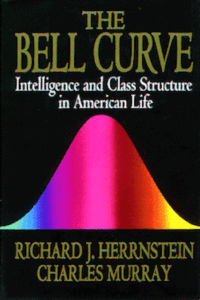
*The Bell Curve was published on this date in 1994. This book has been and remains highly controversial, primarily due to the authors' discussion of purported connections between race and intelligence and their suggested policy implications based on these purported connections.
Its full title, The Bell Curve: Intelligence and Class Structure in American Life, was written by psychologist Richard J. Herrnstein and political scientist Charles Murray. They argue that inherited and environmental factors influence human intelligence and that it is a better predictor of many personal outcomes, including financial income, job performance, out-of-wedlock births, and involvement in crime, than an individual's parental socioeconomic status. They also argue that those with high intelligence, the "cognitive elite," are becoming separated from those of average and below-average intelligence. This separation is a source of social division within the United States.
Since the book provided statistical data asserting that blacks were, on average, less intelligent than whites, some people have argued that Extremists could use the Bell Curve to justify genocide and hate crimes. Much of the work referenced by The Bell Curve was funded by the Pioneer Fund, which aims to advance the scientific study of heredity and human differences and has been accused of promoting white supremacist views, particularly scientific racism. Murray criticized the characterization of the Pioneer Fund as a racist organization, arguing that it has as much relationship to its founder as "Henry Ford and today's Ford Foundation ."
Columnist Bob Herbert, writing for The New York Times, described the book as "a scabrous piece of racial pornography masquerading as serious scholarship ." Mr. Murray can protest all he wants", wrote Herbert; "his book is just a genteel way of calling somebody a nigger." Evolutionary biologist Joseph L. Graves described The Bell Curve as an example of racist science, containing all the types of errors in the application of a scientific method that have characterized the history of scientific racism:
1. Claims that are not supported by the data given
2. Errors in the calculation that invariably support the hypothesis
3. No mention of data that contradicts the hypothesis
4. No mention of theories and data that conflict with core assumptions
5. Bold policy recommendations that are consistent with those advocated by racists.
Shortly after its publication, many people rallied in criticism and defense of the book. Several critical texts were written in response to it. Many criticisms were collected in the book The Bell Curve Debate. Eric Siegel wrote on the Scientific American blog that the book "endorses prejudice by what it does not say. Nowhere does the book address why it investigates racial differences in I.Q. By never spelling out a reason for reporting these differences in the first place, the authors transmit an unspoken yet unmistakable conclusion: Race is a helpful indicator of whether a person is likely to hold certain capabilities. Even if we assume the presented data trends are sound, the book leaves the reader to deduce on their own how to put these insights to use best. The net effect is to condone the prejudgment of individuals based on race tacitly."
Howard Gardner accused the authors of engaging in "scholarly brinkmanship." He argues that "Whether concerning an issue of science, policy, or rhetoric, the authors come dangerously close to embracing the most extreme positions, yet, in the end, shy away from doing so ... Scholarly brinkmanship encourages the reader to draw the strongest conclusions while allowing the authors to disavow this intention."
To be a Writer
To Become an Editor
To Become a Desktop Publisher